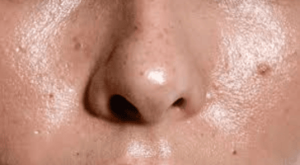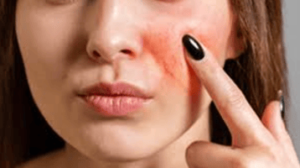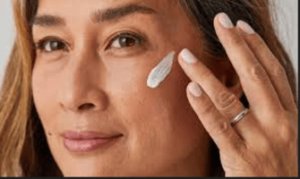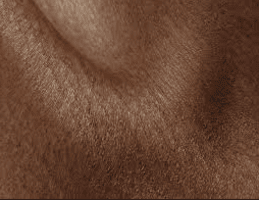- Use gentle chemical exfoliants like lactic acid rather than physical scrubs
- Apply an overnight hydrating mask 1-2 times weekly
- You might want to use a device to maintain some wetness in your bedroom.
Advice on Taking Care of Dry Skin
- Avoid hot water which can further strip moisture
- Seek out skincare products that include niacinamide, glycerin, ceramides, and hyaluronic acid.
- Eat foods high in omega-3 fatty acids and drink lots of water.
- Avoid alcohol-based products which can increase dryness
- Reapply moisturizer throughout the day if needed
Skincare Tips for Oily Skin
Managing oily skin is about balancing oil production without over-drying, which can actually increase sebum production. The right approach includes gentle cleansing and lightweight hydration.
Morning Routine for Oily Skin
- Use a mild foaming or gel cleanser that contains salicylic acid to cleanse.
Use a toner without alcohol that contains niacinamide or witch hazel. - Use a lightweight, oil-free serum with antioxidants
- Choose an oil-free, noncomedogenic moisturizer
- Apply a matte-finish sunscreen
Evening Routine for Oily Skin
- Double cleanse to thoroughly remove oil, makeup, and sunscreen
- Use products containing active ingredients like salicylic acid, niacinamide, or retinol
- Apply a lightweight gel moisturizer
- For breakouts, think about applying sulfur or benzoyl peroxide as spot treatments.

Weekly Treatments for Oily Skin
- Use clay masks to absorb excess oil and clarify pores
- Incorporate chemical exfoliation with BHAs like salicylic acid
- Try oil-absorbing sheet masks when needed
Advice on How to Take Care of Oily Skin
- Don’t skip moisturizer, as dehydration can trigger more oil production
- Look for the terms ‘noncomedogenic’ and ‘oil-free’ on product labels
- Blotting papers can help manage shininess throughout the day
- Using a light-textured face oil at night may help control the production of sebum.
- Be patient with active ingredients and don’t overuse them
Skincare Tips for Combination Skin
A balanced strategy that targets both dry and oily regions is necessary for combination skin. Zone-specific product application is often the key to success.
Morning Routine for Combination Skin
- Use a well-balanced cleanser that avoids stripping of natural oils or overhydrating.
- Use a balancing toner across the entire face
- Apply targeted treatments: hydrating serum on dry areas, oil-control products on the T-zone
- Use a lightweight, balancing moisturizer
- Finish with a suitable SPF product
 Evening Routine for Combination Skin
Evening Routine for Combination Skin
- Double cleanse to get rid of pollutants and makeup
- Use a balanced treatment serum, like niacinamide, which benefits both dry and oily skin
- Use a medium-weight moisturizer, applying more to dry areas and less to oily zones
Weekly Treatments for Combination skin
- Multi-masking: apply clay masks to oily areas and hydrating masks to dry areas
- Use gentle chemical exfoliants across the face, focusing more on congested areas
Advice on How to Take Care of Combination Skin
- Adjust your routine with the seasons as combination skin often becomes drier in winter and oilier in summer
- Consider using different moisturizers for different zones of your face
- Look for products marked for ‘balanced’ or ‘combination’ skin
- Observe how your skin responds and make the necessary adjustments.
Skincare Tips for Sensitive Skin
Sensitive skin requires a cautious approach with gentle products and minimal ingredients to prevent irritation and inflammation.
Morning Routine for Sensitive Skin
- Cleanse with a fragrance-free, sulfate-free cleanse
- Apply a calming toner containing chamomile or green tea.
- Use a basic moisturizer made for sensitive skin
- Finish with a mineral-based sunscreen containing zinc oxide or titanium dioxide
Evening Routine for Sensitive Skin
- Use micellar water or a mild oil cleanser to remove makeup.
- Cleanse with a gentle, creamy cleanser
- Use a calming serum that contains aloe vera or Centella asiatica.
- Use a simple, fragrance-free moisturizer

Weekly Treatments for Sensitive Skin
- Avoid harsh exfoliants; instead opt for enzyme-based exfoliants if needed
- Use calming sheet masks with minimal ingredients
Advice on How to Take Care of Sensitive Skin
- Always patch test new products on your inner arm before applying to your face
- Avoid fragranced products, essential oils, alcohol, and common irritants
- Look for products specifically formulated for sensitive skin with minimal ingredient lists
- Consider keeping skincare products in the refrigerator for an added cooling effect
- See a dermatologist if the sensitivity continues or gets worse.
Skincare Tips for Acne-Prone Skin
Acne-prone skin requires a careful balance of targeted treatment and gentle care to address breakouts without causing irritation or worsening inflammation.
Morning Routine for Acne-Prone Skin
- Cleanse with a gentle cleanser containing salicylic acid or benzoyl peroxide
- Use a toner without alcohol that contains tea tree oil or witch hazel.
- Use a lightweight treatment serum with niacinamide or azelaic acid
- Apply a lightweight, oil-free, noncomedogenic moisturizer
- Finish with a broad-spectrum SPF 30 or higher that’s labeled noncomedogenic
Evening Routine for Acne-Prone Skin
- To completely get rid of pollutants, sunscreen, and makeup, double cleanse with oil and foam cleansers
- Apply active treatment products containing ingredients like salicylic acid, benzoyl peroxide, or retinoids
- To stay hydrated, apply a mild, oil-free moisturizer.
- Consider spot treatments with ingredients like sulfur or tea tree oil for active breakouts
Weekly Treatments for Acne-Prone Skin
- Use chemical exfoliants containing AHAs or BHAs rather than physical scrubs
- Apply clay or charcoal masks to draw out impurities
- Consider sulfur masks for occasional use on very congested areas

Advice on How to Take Care of Acne-Prone Skin
- Resist the urge to pick or pop blemishes as this can lead to scarring and spread bacteria
- Change pillowcases frequently to avoid bacterial buildup
- Cleanse skin after sweating heavily during exercise
- Avoid pore-clogging ingredients like cocoa butter, coconut oil, and lanolin
- Check for skincare products with the term ‘noncomedogenic’ or ‘won’t clog pores’
- Be patient with acne treatments—most require at least 6-8 weeks to show significant improvement
- Consider consulting a dermatologist for persistent acne, especially if over-the-counter products aren’t helping
- Pay attention to diet—some people find that dairy, high-glycemic foods, or specific triggers worsen their acne
Skincare Tips for Mature Skin
Mature skin benefits from ingredients that support collagen production, increase cell turnover, and provide deep hydration to address multiple concerns simultaneously.
Morning Routine for Mature Skin
- Cleanse with a hydrating, creamy cleanser
- Apply an antioxidant serum rich in vitamin C
- Use a peptide or growth factor serum to support collagen
- Apply a rich moisturizer containing ceramides and niacinamide
- Finish with a broad-spectrum SPF 50 sunscreen
Evening Routine for Mature Skin
- Double cleanse to thoroughly remove makeup and sunscreen
- Apply retinol or bakuchiol serum to promote cell turnover
- Layer a hydrating serum containing hyaluronic acid
- Apply a facial oil or rich night cream that contains regenerative ingredients.
Weekly Treatments for Mature Skin
- Gentle exfoliation with AHAs to brighten and smooth
- Hydrating sheet masks or overnight masks rich in peptides and antioxidants
 Advice on How to Take Care of Mature Skin
Advice on How to Take Care of Mature Skin
- Prioritize sun protection as UV damage accelerates aging
- Incorporate facial massage techniques to improve circulation
- Look for products containing retinoids, peptides, antioxidants, and growth factors
- Stay hydrated and keep a diet high in antioxidants
- Consider professional treatments like microcurrent facials or LED therapy
General Skincare Tips for All Skin Types
Regardless of your specific skin type, certain universal principles apply to maintaining healthy skin:
Healthy Lifestyle Habits
- Drink enough water each day to stay adequately hydrated
- Eat a balanced diet full of vital minerals, healthy fats, and antioxidants.
- Get sufficient sleep to allow skin cells to regenerate
- Manage stress through mindfulness, exercise, or other techniques
- Avoid smoking and limit alcohol consumption
Environmental Protection
- Apply broad-spectrum sunscreen every day, regardless of the weather.
- When you’re outside, reapply sunscreen every two hours
- Wear protective clothing like sunglasses and caps.
- Be aware of environmental pollution and cleanse thoroughly in the evening
Product Selection and Usage
- To find possible reactions, introduce new skincare products one at a time.
- Follow the thinnest-to-thickest rule when applying products
- Don’t overload your skin with too many active ingredients
- Consistency is key—give products time to work before switching
- As the demands of your skin change with the seasons, modify your routine.
FAQs
How can I find out what type of skin I have at home?
You can perform a simple test by washing your face with a mild cleanser, patting it dry, and waiting an hour without applying any products. You probably have dry skin if it feels tight; oily skin if it appears glossy everywhere; and combination skin if it’s shiny primarily in the T-zone.
If your skin feels comfortable and neither oily nor dry, you likely have normal skin. Sensitive skin will often feel irritated after using new products or show redness and reactivity. Acne-prone skin will regularly develop breakouts regardless of your care routine.
How often should I change my skincare routine?
Seasons, hormonal changes, aging, and environmental variables all affect the demands of your skin. Generally, it’s good to assess your routine seasonally, making adjustments for winter dryness or summer humidity.
However, if your current routine is working well, don’t change it just because a new product is trending. Listen to your skin and make gradual adjustments when needed.
How long does it take for a new skincare product to start working?
The timeline varies depending on the product and your skin concerns. When using moisturizing products, you may notice results right away.
Products targeting concerns like hyperpigmentation, fine lines, or acne typically take 4-12 weeks to show significant improvement, as this aligns with your skin’s natural renewal cycle. Consistency is important for seeing results.
How can I transition between skincare routines safely?
When changing routines, introduce new products one at a time, waiting at least a week between additions to monitor for any adverse reactions. Start with the most essential steps (cleanser, moisturizer, sunscreen) before adding treatment products.
If introducing active ingredients like retinoids or acids, begin with a lower concentration and reduced frequency, gradually increasing as your skin builds tolerance.
Does my skin type change over time?
Yes, your skin type can change due to factors including age, hormonal fluctuations, climate, seasons, and lifestyle changes. Many people experience drier skin as they age due to decreased oil production.
Hormonal changes during pregnancy or menopause can significantly alter skin behavior. It’s important to periodically reassess your skin type and adjust your skincare routine accordingly.
Conclusion…
Understanding and properly caring for your specific skin type is fundamental to achieving healthy, radiant skin. As we’ve explored throughout this guide, there’s no one-size-fits-all approach to skincare.What works beautifully for dry skin might cause breakouts for oily skin, and products designed for normal skin might irritate sensitive skin.
By identifying your unique skin type—whether it’s normal, dry, oily, combination, sensitive, acne-prone, or mature—and following the tailored recommendations provided, you can build a skincare routine that addresses your specific needs and concerns. Keep in mind that the secret to any skincare routine is consistency.
While it’s tempting to try every new product that hits the market, your skin benefits most from a steady, thoughtful approach with products formulated for your skin type. Additionally, factors beyond topical skincare—including diet, hydration, sleep, and stress management—play crucial roles in skin health. Consider your skincare routine as part of a holistic approach to self-care.
Finally, be patient and gentle with your skin. Results take time, especially for concerns like hyperpigmentation, fine lines, or persistent acne. By understanding your skin type and providing it with appropriate care, you’re laying the foundation for not just temporary improvements but long-term skin health.
Whether you have normal, dry, oily, combination, sensitive, acne-prone, or mature skin, the right approach can help you achieve your best skin yet.
Achieving healthy, glowing skin requires more than just washing your face daily and applying random products. Understanding your unique skin type is the foundation of effective skincare, yet many people struggle with identifying their specific skin type and finding appropriate care routines.
If you’ve ever wondered why certain products work wonders for your friends but cause breakouts or irritation for you, the answer likely lies in your skin type. Your skin is as unique as your fingerprint, with its own set of characteristics and requirements.
Whether you’re dealing with persistent dryness, excess oil production, sensitivity, or a combination of concerns, this article will provide tailored advice for each skin type. We’ll explore the seven main skin types—normal, dry, oily, combination, sensitive, acne-prone, and mature—and share expert-backed tips to help you achieve your skin goals.
By the end of this guide, you’ll have a clearer understanding of how to identify your skin type and how to care for it properly, setting you on the path to healthier, more radiant skin.

Understanding Your Skin Type
Before diving into specific care routines, it’s essential to accurately identify your skin type. Your skin type is determined by genetics, though it can be influenced by various factors including climate, season, hormones, and lifestyle.
Let’s examine the characteristics of each skin type:
Normal Skin
- Balanced oil production
- Neither too dry nor too oily
- Small, barely visible pores
- Smooth texture with good elasticity
- Few imperfections
- Not prone to sensitivity

Dry Skin
- Feels tight, especially after cleansing
- May appear dull or rough
- Fine lines and wrinkles are more obvious.
- May experience flaking or peeling
- Has small pores
- Prone to irritation and redness
Oily Skin
- Excess sebum production
- • A shiny or oily look, particularly in the T-zone
- Enlarged, visible pores
- Prone to blackheads, whiteheads, and acne
- Makeup tends to slide off quickly
- Thicker texture with good elasticity
Combination Skin
- T-zones are Oily (chin, forehead and nose)
- Dry or normal on the cheeks
- Enlarged pores in oily areas
- Uneven skin texture
- Occasional breakouts in oily areas
Sensitive Skin
- Reacts easily to products, environment, or stress
- May appear red or blotchy
- Feels itchy, tight, or burning
- Prone to rashes and bumps
- Can overlap with other skin types
Acne-Prone Skin
- Frequent breakouts of various types (whiteheads, blackheads, papules, pustules, cysts)
- May have post-inflammatory hyperpigmentation or scarring
- • Usually oily, although occasionally dry or a mix of the two
- Inflamed, red, or painful blemishes
- Pores may be enlarged and congested
- Skin may be sensitive to many ingredients
Mature Skin
- Reduced elasticity and firmness
- More visible fine lines and wrinkles
- Increased dryness and thinning
- Uneven tone with age spots or hyperpigmentation
- Can overlap with other skin types
Skincare Tips for Normal Skin
Those blessed with normal skin have the easiest maintenance routine, but this doesn’t mean you should neglect proper care. The goal is to preserve the natural balance while providing adequate protection.
 Morning Routine for Normal Skin
Morning Routine for Normal Skin
- Cleanse with a gentle, pH-balanced cleanser
- • Use a vitamin C-containing antioxidant serum to guard against environmental harm.
- Use a lightweight moisturizer with SPF 30 or higher
Evening Routine for Normal Skin
- Use a mild makeup remover to get rid of makeup
- Cleanse to remove remaining impurities
- • Use a moisturizing serum that contains hyaluronic acid.
- Finish with a nourishing night cream
Weekly Treatments for Normal Skin
- Exfoliate once or twice weekly to remove dead skin cells and maintain brightness
- Apply a moisturizing mask to enhance moisture and retain suppleness
Tips on How to Take Care of Normal Skin
- To keep your skin’s balance, stick to your routine.
- Adjust your moisturizer depending on seasonal changes
- Don’t overdo active ingredients as this can disrupt your skin’s natural balance
- Maintain healthy lifestyle habits including adequate hydration and sleep
Skincare Tips for Dry Skin
Dry skin requires extra attention to restore and maintain hydration levels. The key to managing dry skin is incorporating moisture-rich products at every step of your routine.
Morning Routine for Dry Skin
- Use an oil-based cleanser or cream to cleanse that would not remove natural oils.
- Apply a hydrating toner or essence containing glycerin or hyaluronic acid
- Layer a moisture-boosting serum
- Use a rich moisturizer with ceramides and fatty acids
- Finish with a broad-spectrum SPF 30 or higher
 Evening Routine for Dry Skin
Evening Routine for Dry Skin
- Remove makeup with an oil or balm cleanser
- Follow with a gentle, hydrating second cleanse if needed
- Use a moisturizing serum when the skin is still a bit wet from bathing
- Use a thicker night cream or facial oil
- Consider applying an occlusive product like petroleum jelly to very dry areas
Weekly Treatments for Dry Skin
- Use gentle chemical exfoliants like lactic acid rather than physical scrubs
- Apply an overnight hydrating mask 1-2 times weekly
- You might want to use a device to maintain some wetness in your bedroom.
Advice on Taking Care of Dry Skin
- Avoid hot water which can further strip moisture
- Seek out skincare products that include niacinamide, glycerin, ceramides, and hyaluronic acid.
- Eat foods high in omega-3 fatty acids and drink lots of water.
- Avoid alcohol-based products which can increase dryness
- Reapply moisturizer throughout the day if needed
Skincare Tips for Oily Skin
Managing oily skin is about balancing oil production without over-drying, which can actually increase sebum production. The right approach includes gentle cleansing and lightweight hydration.
Morning Routine for Oily Skin
- Use a mild foaming or gel cleanser that contains salicylic acid to cleanse.
Use a toner without alcohol that contains niacinamide or witch hazel. - Use a lightweight, oil-free serum with antioxidants
- Choose an oil-free, noncomedogenic moisturizer
- Apply a matte-finish sunscreen
Evening Routine for Oily Skin
- Double cleanse to thoroughly remove oil, makeup, and sunscreen
- Use products containing active ingredients like salicylic acid, niacinamide, or retinol
- Apply a lightweight gel moisturizer
- For breakouts, think about applying sulfur or benzoyl peroxide as spot treatments.

Weekly Treatments for Oily Skin
- Use clay masks to absorb excess oil and clarify pores
- Incorporate chemical exfoliation with BHAs like salicylic acid
- Try oil-absorbing sheet masks when needed
Advice on How to Take Care of Oily Skin
- Don’t skip moisturizer, as dehydration can trigger more oil production
- Look for the terms ‘noncomedogenic’ and ‘oil-free’ on product labels
- Blotting papers can help manage shininess throughout the day
- Using a light-textured face oil at night may help control the production of sebum.
- Be patient with active ingredients and don’t overuse them
Skincare Tips for Combination Skin
A balanced strategy that targets both dry and oily regions is necessary for combination skin. Zone-specific product application is often the key to success.
Morning Routine for Combination Skin
- Use a well-balanced cleanser that avoids stripping of natural oils or overhydrating.
- Use a balancing toner across the entire face
- Apply targeted treatments: hydrating serum on dry areas, oil-control products on the T-zone
- Use a lightweight, balancing moisturizer
- Finish with a suitable SPF product
 Evening Routine for Combination Skin
Evening Routine for Combination Skin
- Double cleanse to get rid of pollutants and makeup
- Use a balanced treatment serum, like niacinamide, which benefits both dry and oily skin
- Use a medium-weight moisturizer, applying more to dry areas and less to oily zones
Weekly Treatments for Combination skin
- Multi-masking: apply clay masks to oily areas and hydrating masks to dry areas
- Use gentle chemical exfoliants across the face, focusing more on congested areas
Advice on How to Take Care of Combination Skin
- Adjust your routine with the seasons as combination skin often becomes drier in winter and oilier in summer
- Consider using different moisturizers for different zones of your face
- Look for products marked for ‘balanced’ or ‘combination’ skin
- Observe how your skin responds and make the necessary adjustments.
Skincare Tips for Sensitive Skin
Sensitive skin requires a cautious approach with gentle products and minimal ingredients to prevent irritation and inflammation.
Morning Routine for Sensitive Skin
- Cleanse with a fragrance-free, sulfate-free cleanse
- Apply a calming toner containing chamomile or green tea.
- Use a basic moisturizer made for sensitive skin
- Finish with a mineral-based sunscreen containing zinc oxide or titanium dioxide
Evening Routine for Sensitive Skin
- Use micellar water or a mild oil cleanser to remove makeup.
- Cleanse with a gentle, creamy cleanser
- Use a calming serum that contains aloe vera or Centella asiatica.
- Use a simple, fragrance-free moisturizer

Weekly Treatments for Sensitive Skin
- Avoid harsh exfoliants; instead opt for enzyme-based exfoliants if needed
- Use calming sheet masks with minimal ingredients
Advice on How to Take Care of Sensitive Skin
- Always patch test new products on your inner arm before applying to your face
- Avoid fragranced products, essential oils, alcohol, and common irritants
- Look for products specifically formulated for sensitive skin with minimal ingredient lists
- Consider keeping skincare products in the refrigerator for an added cooling effect
- See a dermatologist if the sensitivity continues or gets worse.
Skincare Tips for Acne-Prone Skin
Acne-prone skin requires a careful balance of targeted treatment and gentle care to address breakouts without causing irritation or worsening inflammation.
Morning Routine for Acne-Prone Skin
- Cleanse with a gentle cleanser containing salicylic acid or benzoyl peroxide
- Use a toner without alcohol that contains tea tree oil or witch hazel.
- Use a lightweight treatment serum with niacinamide or azelaic acid
- Apply a lightweight, oil-free, noncomedogenic moisturizer
- Finish with a broad-spectrum SPF 30 or higher that’s labeled noncomedogenic
Evening Routine for Acne-Prone Skin
- To completely get rid of pollutants, sunscreen, and makeup, double cleanse with oil and foam cleansers
- Apply active treatment products containing ingredients like salicylic acid, benzoyl peroxide, or retinoids
- To stay hydrated, apply a mild, oil-free moisturizer.
- Consider spot treatments with ingredients like sulfur or tea tree oil for active breakouts
Weekly Treatments for Acne-Prone Skin
- Use chemical exfoliants containing AHAs or BHAs rather than physical scrubs
- Apply clay or charcoal masks to draw out impurities
- Consider sulfur masks for occasional use on very congested areas

Advice on How to Take Care of Acne-Prone Skin
- Resist the urge to pick or pop blemishes as this can lead to scarring and spread bacteria
- Change pillowcases frequently to avoid bacterial buildup
- Cleanse skin after sweating heavily during exercise
- Avoid pore-clogging ingredients like cocoa butter, coconut oil, and lanolin
- Check for skincare products with the term ‘noncomedogenic’ or ‘won’t clog pores’
- Be patient with acne treatments—most require at least 6-8 weeks to show significant improvement
- Consider consulting a dermatologist for persistent acne, especially if over-the-counter products aren’t helping
- Pay attention to diet—some people find that dairy, high-glycemic foods, or specific triggers worsen their acne
Skincare Tips for Mature Skin
Mature skin benefits from ingredients that support collagen production, increase cell turnover, and provide deep hydration to address multiple concerns simultaneously.
Morning Routine for Mature Skin
- Cleanse with a hydrating, creamy cleanser
- Apply an antioxidant serum rich in vitamin C
- Use a peptide or growth factor serum to support collagen
- Apply a rich moisturizer containing ceramides and niacinamide
- Finish with a broad-spectrum SPF 50 sunscreen
Evening Routine for Mature Skin
- Double cleanse to thoroughly remove makeup and sunscreen
- Apply retinol or bakuchiol serum to promote cell turnover
- Layer a hydrating serum containing hyaluronic acid
- Apply a facial oil or rich night cream that contains regenerative ingredients.
Weekly Treatments for Mature Skin
- Gentle exfoliation with AHAs to brighten and smooth
- Hydrating sheet masks or overnight masks rich in peptides and antioxidants
 Advice on How to Take Care of Mature Skin
Advice on How to Take Care of Mature Skin
- Prioritize sun protection as UV damage accelerates aging
- Incorporate facial massage techniques to improve circulation
- Look for products containing retinoids, peptides, antioxidants, and growth factors
- Stay hydrated and keep a diet high in antioxidants
- Consider professional treatments like microcurrent facials or LED therapy
General Skincare Tips for All Skin Types
Regardless of your specific skin type, certain universal principles apply to maintaining healthy skin:
Healthy Lifestyle Habits
- Drink enough water each day to stay adequately hydrated
- Eat a balanced diet full of vital minerals, healthy fats, and antioxidants.
- Get sufficient sleep to allow skin cells to regenerate
- Manage stress through mindfulness, exercise, or other techniques
- Avoid smoking and limit alcohol consumption
Environmental Protection
- Apply broad-spectrum sunscreen every day, regardless of the weather.
- When you’re outside, reapply sunscreen every two hours
- Wear protective clothing like sunglasses and caps.
- Be aware of environmental pollution and cleanse thoroughly in the evening
Product Selection and Usage
- To find possible reactions, introduce new skincare products one at a time.
- Follow the thinnest-to-thickest rule when applying products
- Don’t overload your skin with too many active ingredients
- Consistency is key—give products time to work before switching
- As the demands of your skin change with the seasons, modify your routine.
FAQs
How can I find out what type of skin I have at home?
You can perform a simple test by washing your face with a mild cleanser, patting it dry, and waiting an hour without applying any products. You probably have dry skin if it feels tight; oily skin if it appears glossy everywhere; and combination skin if it’s shiny primarily in the T-zone.
If your skin feels comfortable and neither oily nor dry, you likely have normal skin. Sensitive skin will often feel irritated after using new products or show redness and reactivity. Acne-prone skin will regularly develop breakouts regardless of your care routine.
How often should I change my skincare routine?
Seasons, hormonal changes, aging, and environmental variables all affect the demands of your skin. Generally, it’s good to assess your routine seasonally, making adjustments for winter dryness or summer humidity.
However, if your current routine is working well, don’t change it just because a new product is trending. Listen to your skin and make gradual adjustments when needed.
How long does it take for a new skincare product to start working?
The timeline varies depending on the product and your skin concerns. When using moisturizing products, you may notice results right away.
Products targeting concerns like hyperpigmentation, fine lines, or acne typically take 4-12 weeks to show significant improvement, as this aligns with your skin’s natural renewal cycle. Consistency is important for seeing results.
How can I transition between skincare routines safely?
When changing routines, introduce new products one at a time, waiting at least a week between additions to monitor for any adverse reactions. Start with the most essential steps (cleanser, moisturizer, sunscreen) before adding treatment products.
If introducing active ingredients like retinoids or acids, begin with a lower concentration and reduced frequency, gradually increasing as your skin builds tolerance.
Does my skin type change over time?
Yes, your skin type can change due to factors including age, hormonal fluctuations, climate, seasons, and lifestyle changes. Many people experience drier skin as they age due to decreased oil production.
Hormonal changes during pregnancy or menopause can significantly alter skin behavior. It’s important to periodically reassess your skin type and adjust your skincare routine accordingly.
Conclusion…
Understanding and properly caring for your specific skin type is fundamental to achieving healthy, radiant skin. As we’ve explored throughout this guide, there’s no one-size-fits-all approach to skincare.What works beautifully for dry skin might cause breakouts for oily skin, and products designed for normal skin might irritate sensitive skin.
By identifying your unique skin type—whether it’s normal, dry, oily, combination, sensitive, acne-prone, or mature—and following the tailored recommendations provided, you can build a skincare routine that addresses your specific needs and concerns. Keep in mind that the secret to any skincare routine is consistency.
While it’s tempting to try every new product that hits the market, your skin benefits most from a steady, thoughtful approach with products formulated for your skin type. Additionally, factors beyond topical skincare—including diet, hydration, sleep, and stress management—play crucial roles in skin health. Consider your skincare routine as part of a holistic approach to self-care.
Finally, be patient and gentle with your skin. Results take time, especially for concerns like hyperpigmentation, fine lines, or persistent acne. By understanding your skin type and providing it with appropriate care, you’re laying the foundation for not just temporary improvements but long-term skin health.
Whether you have normal, dry, oily, combination, sensitive, acne-prone, or mature skin, the right approach can help you achieve your best skin yet.



